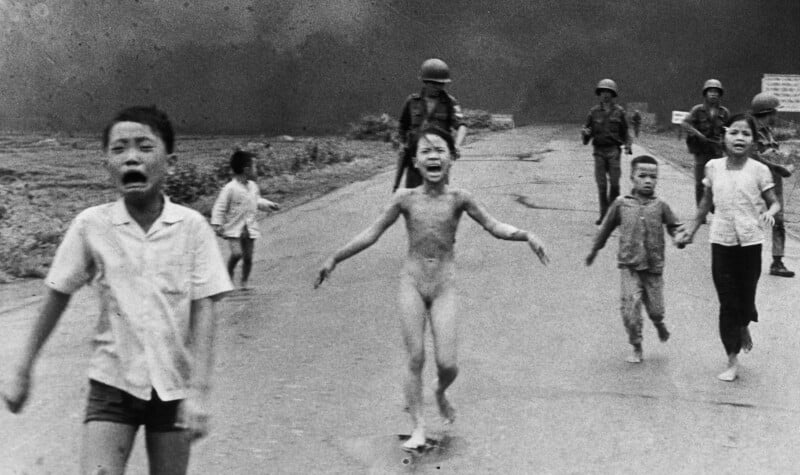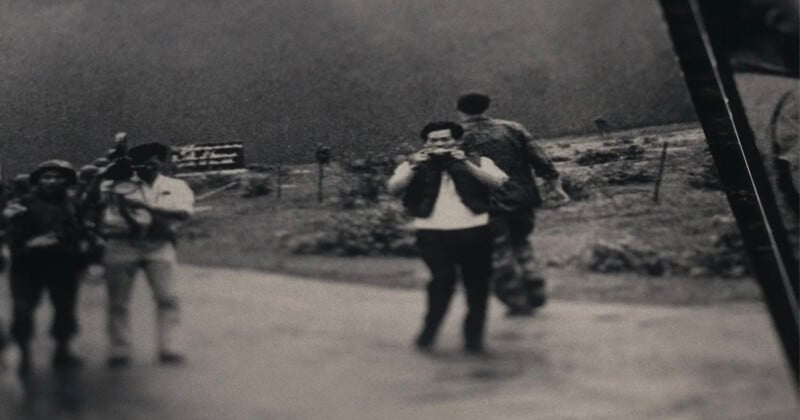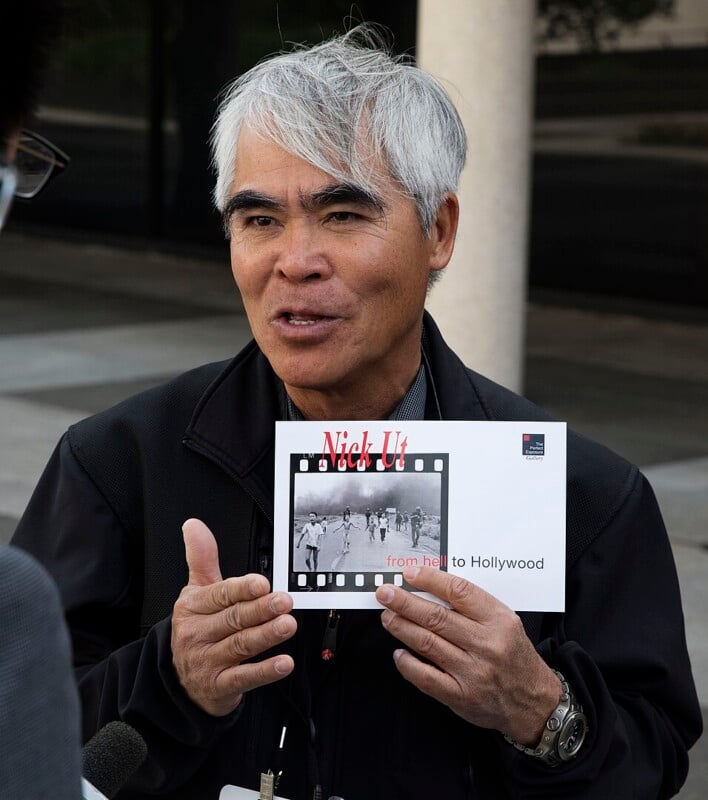The AP Will Not Change Nick Ut’s Credit on ‘Napalm Girl’ Photo

The Associated Press (AP) has released an extensive report looking at whether Nick Ut is the author of the Vietnam War Napalm Girl image. After a detailed investigation, it has decided that it will not change the credit on the famous photograph.
The investigation follows the screening of The Stringer documentary earlier this year which claims Ut did not take the photo and instead names Vietnamese freelancer, Thanh Nghe, as the photographer.
In response to the accusation, the AP has spent a year conducting its own investigation into the events that took place in Trang Bang, South Vietnam, on June 8, 1972, when Phan Thi Kim Phuc was captured by cameras running away from a napalm strike along with other children. In it, AP says that it completed an analysis of all available footage and photography from that day (including some not previously published), conducted a series of interviews with relevant parties, attempted to interview Nguyen Thanh Nghe and former AP photo editor Carl Robinson (both declined but submitted answers to questions in writing), inspected more than a dozen cameras, scrutinized all the photos of that day in the AP archive (and analyzing the detailed differences between negatives), and built a 3D model to analyze the scene, geography, and distances between people. In short, the AP took the assertions in The Stringer seriously and performed an exhaustive investigation before coming to its conclusion about the photo.
“AP’s sole interest in conducting an investigation into the famous AP photo, ‘The Terror of War,’ commonly known as ‘Napalm Girl,’ is ensuring authorship of the iconic image is fairly and accurately recorded. AP has historically not shied away from taking a hard look at its past, and that is indeed what The Associated Press has done here,” the report reads.

“No one is disputing the accuracy of the image, nor that the image is AP’s. The goal of this investigation is purely to establish an accurate historical record. No one who worked for AP involved on either side of this story remains at the company. All have died, retired, or left. A team of AP journalists has spent almost a year investigating this image, which for more than 50 years was believed to have been taken by Huynh Cong Ut, known as Nick Ut.”
The Allegations
The Stringer documentary has to this point only been shown at Sundance Film Festival earlier this year and therefore very few people have seen it — PetaPixel has repeatedly asked for a screening of the film but has been denied. In the film, a reconstruction of the day’s events is shown which leads to the conclusion that Ut could not have been present on the road when the photo was taken.
In the film’s poster, there is a photo of Thanh Nghe holding a camera as Kim Phuc, unseen, runs by on the road. The AP confirms that Nghe was there that day but while the agency is open to the possibility he could have taken the photo, it remains unconvinced.

Nghe says that after he shot the photos, he handed the unprocessed negatives to AP and the following day, returned to be told the agency would buy one photo for $20. Along with the cash, he received two fresh rolls of film and a print of the photo which Nghe says was the “Napalm Girl” photo. Nghe also says he never saw the negative that he shot and wasn’t there when the film was processed. Nghe claims that he did not realize Ut had been credited on the photo until “six or seven months” later when he was informed by an unidentified AP employee. This, despite the fact the photo hit the front pages of newspapers across the world the day after it was taken, immediately causing a stir.
When Nghe went to look for proof that he was the author, he says he found that his wife had torn up the print the AP had given him and thrown it in the trash. He also says he lost all of his other negatives when his family was forced to leave Vietnam in a hurry.
His daughter Janine Nguyen tells AP that, “this was the one and only occasion he sold a photo to any international media.”
However, in the documentary, Nghe is reportedly “portrayed as a seasoned visual journalist” who was “routinely mistreated by Western news organizations.”
Investigating The Camera
AP says that its investigation — which it insists it has carried out with “deep humility” — has found that it is unlikely that Ut took the photo on a Leica M2, as is often credited. Ut has said in multiple interviews that that day he was carrying two Leicas and two Nikons. The Leica M2 that purportedly took the Napalm Girl photo was donated to the now-closed Newseum in Washington D.C.
The AP borrowed that camera and shot three rolls of film through it in a bid to find a match. It not only found that it’s unlikely Ut shot the photo on the camera, but it appears the photo was not taken on any Leica.
“It was also likely, though not certain, the image was taken with a Pentax camera, though some Nikon cameras had similar characteristics to some Pentax cameras of the same era,” the report reads.
Ut says he never had any reason to doubt the photo was shot with a Leica and that Horst Faas, the chief of photos in Saigon, told him that the photo had been shot by a Leica. Ut did use Pentax cameras in Vietnam — specifically his deceased brother’s Pentax. This was confirmed by his brother’s widow Arlett Hieu Salazar.
Reconstructing The Scene
As AP notes, any effort to reconstruct exactly what happened that day on the road to Trang Bang is a difficult task. Photographer David Burnett was on the road that day while on assignment for The New York Times. He missed Kim Phuc running from the village because he was changing film at that moment.
“There’s nothing that ever has given me pause to think that Nick didn’t shoot that picture,” Burnett tells the AP.
While The Stringer reportedly spends a large chunk of the documentary recreating the day to prove Ut didn’t take the photo, the available footage taken by news crews that were also present is limited and contains gaps.
“There are no timestamps on the footage or the photos, so any estimate of the timing and duration of the events is at best an estimate,” adds AP.
A Messy Investigation
The claims in the film originate from former Associated Press photo editor Carl Robinson who was working at the Saigon bureau the day when the photograph was taken.
The established story of The Terror of War (the photograph’s official name) goes that upon seeing the image, Robinson believed the full-frontal nudity in the image rendered it unusable but he was overruled by the chief of photos in Saigon, Horst Faas. Robinson claims that Faas leaned into his ear as he was typing in the credit for the picture and said, “Nick Ut. Make it Nick Ut.” Robinson says he hesitated, but he changed the credit.

“You would have to believe that Faas, who was not at Trang Bang, would know that when he miscredited the photo no one on the road would contradict him or even cast doubt on it,” the AP writes. “You would have to believe that Faas knew that Nghe, whose brother-in-law worked for NBC in the office next door, would not hear of the miscredit and complain. And he would have to be so sure of that; that he would give him a print of the famous photo, which he could have used as proof that he had taken it.”
PetaPixel asked AP how important establishing authorship of the image is, now that we’re 50 years in the future.
“At a time when journalism is under assault and the definition of truth and eyewitness is being called into question, it’s important that we hold ourselves to account,” a spokesperson for the AP says.
The AP’s full 97-page report can be downloaded here.